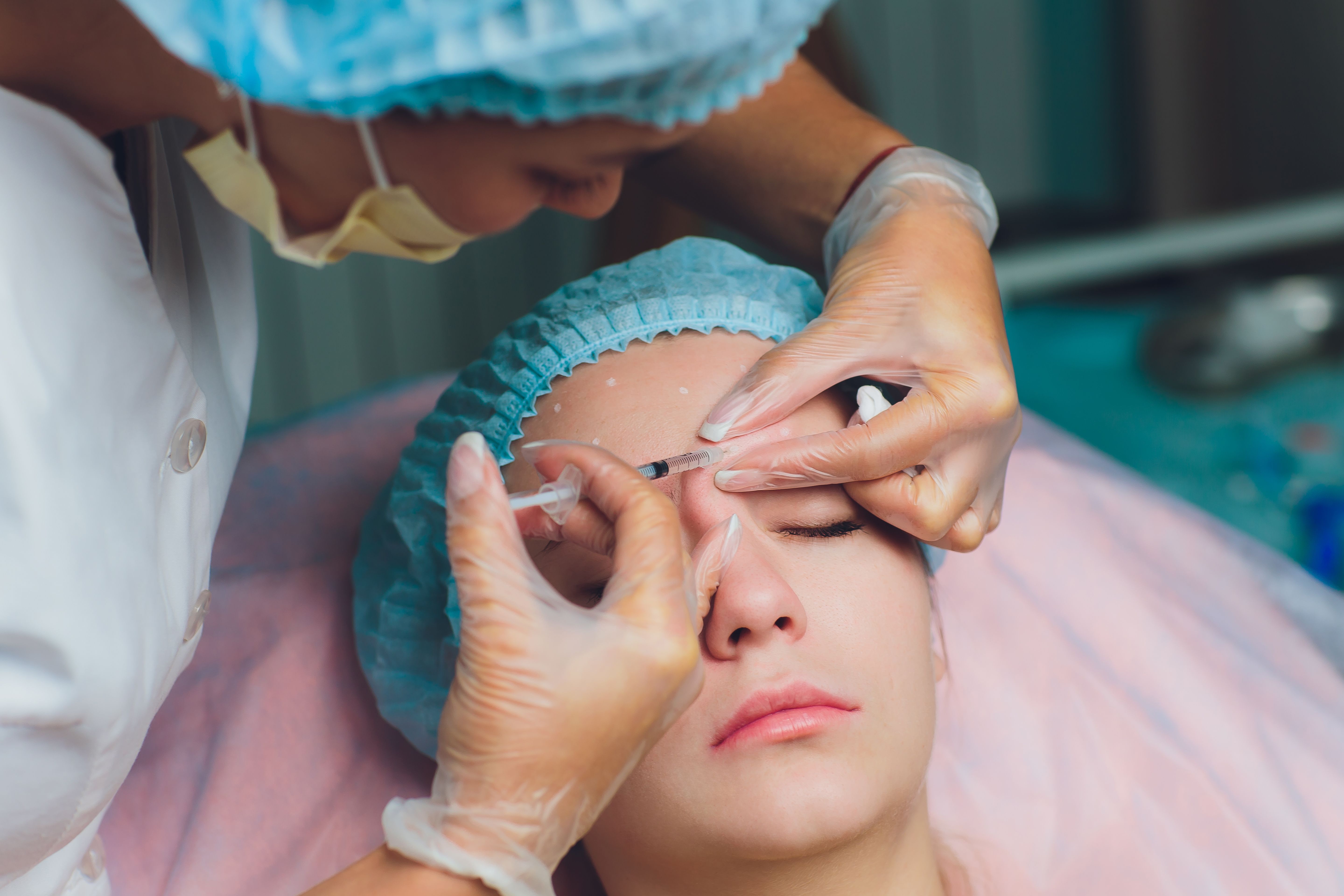- Acne
- Actinic Keratosis
- Aesthetics
- Alopecia
- Atopic Dermatitis
- Buy-and-Bill
- COVID-19
- Case-Based Roundtable
- Chronic Hand Eczema
- Chronic Spontaneous Urticaria
- Drug Watch
- Eczema
- General Dermatology
- Hidradenitis Suppurativa
- Melasma
- NP and PA
- Pediatric Dermatology
- Pigmentary Disorders
- Practice Management
- Precision Medicine and Biologics
- Prurigo Nodularis
- Psoriasis
- Psoriatic Arthritis
- Rare Disease
- Rosacea
- Skin Cancer
- Vitiligo
- Wound Care
Article
6 Tips to prevent, manage injectable complications
Author(s):
Kevin S. Pinski, M.D., shared what providers need to know and do to prevent and manage injectable complications at the Maui Derm NP + PA summer 2019 meeting.
Kevin S. Pinski, M.D., shared what providers need to know and do to prevent and manage injectable complications at the Maui Derm NP + PA summer 2019 meeting. (Евгений Вершинин - stock.adobe.com)

Complications associated with dermal fillers and neuromodulators are rare and often avoidable. But when they occur – they do even in the best hands and using the best technique – there are things providers can do to prevent serious problems and keep their patients, according to Kevin S. Pinski, M.D., medical director of Pinski Dermatology and Cosmetic Surgery in Chicago.
READ MORE: Preparing for filler complications
“Prevention is always better than management of complications,” says Dr. Pinski, who presented at the Maui Derm NP + PA summer 2019 meeting on recognizing and avoiding filler and neuromodulator complications. “Most of the complications are technique dependent. They’re not due to the products we inject - fillers and toxins.”
Dr. Pinski shares what providers need to know and do to prevent and manage injectable complications.
1. Know your patient
A big complication that many providers don’t consider is performing procedures on patients who have unrealistic expectations, according to Dr. Pinski.
“You need to know your patients’ expectations and their reasons for wanting the treatments,” he says. “Keep in mind the patient’s gender and ethnicity. You don’t want to feminize a male patient or masculinize a female patient. And there are certain ethnic differences that we want to maintain.”
2. Know your product.
There isn’t one product that does it all. Make sure that the product that you’re using is indicated for what you’re doing, according to Dr. Pinski.
READ MORE: Fillers for less common areas
Basic considerations include that fillers don’t do the same thing neuromodulators do and vice versa.
Some fillers are better for revolumization, such as Juvedérm Voluma (Allergan), Radiesse (Merz) or Restylane Lyft (Galderma). Some fillers are for fine lines, such as Juvedérm Volbella (Allergan), Belotero Balance (Merz) and Restylane Silk (Galderma).
“These are not interchangeable. You can’t use a fine-line filler in somebody’s cheeks to get volume. It’s not going to last and it’s not going to give near the result that the patient or injector would want,” he says.
Based on the products providers use, they should make sure to place it correctly and use the proper amount.
“There are differences between various neuromodulators. Units of Botox [Allergan] do not equal units of Xeomin [Merz] or Dysport [Ipsen]. So you need to know equivalent unit ratios,” Dr. Pinski says.
Placing revolumizing fillers too superficially can lead to problems like discoloration or nodules. One might be able to use a superficial injecting technique with fillers for fine lines, however.
READ MORE: How to apply the science of neuromodulators to practice
3. Know your anatomy
If you know your anatomy and are a careful injector, you’re going to prevent a large majority of potential complications, according to Dr. Pinski.
“Know your muscles for neuromodulators. Know the vasculature; know the danger zones, including certain arterial vessels and parotid glands,” he says. “Stay in a more superficial plane, such as deep intradermal or superficial subcutaneous rather than much deeper where you’re going to run into potential issues with vascular compromise or parotid duct occlusion.”
4. Know your technique.
Dr. Pinski’s mantra is: low volume and slow injection technique for fillers. This helps with not only optimal outcomes but also better pain control.
“One of the reasons patients don’t come back is they experienced pain during injection. Certainly, people will put up with a certain amount of pain with good results, but given painless versus painful, they’re always going to go for the painless injection,” he said. “Injecting slowly and with less volume causes less pain. There will be less swelling and bruising as well.”
5. Know how to recognize, quickly treat complications that occur
Know how to diagnose and be ready to quickly treat complications. Providers should know what to do, for example, for nodules or lumps. This is where hyaluronidase comes into play, post hyaluronic acid filler injection.
READ MORE: An alternative approach to vertical lip lines
“Hopefully you don’t have to use it too often but it should be available at all times to anybody utilizing hyaluronic acid fillers,” Dr. Pinski says. “If your patient gets a vascular occlusion -the one that we all really worry about - you need to be able to recognize it and hopefully reverse it with hyaluronidase, massage, topical nitroglycerin paste or aspirin taken internally. Anything to dilate the vessel.”
If the patient develops a granuloma, an inflammatory nodule, providers typically will manage that with proper antibiotic prescribing. But the first step is prevention by using proper aseptic technique.
“I love hypochlorous acid as a prep. It’s readily obtainable and it’s a wonderful product. It’s nontoxic if you happen to get it into the eyes or mouth,” Dr. Pinski says.
Among the most common neuromodulator complications are asymmetry, bruising and ptosis of the eyelids or eyebrows. Providers can prevent those by knowing the anatomy and proper planning in how to reverse it if it does happen.
“If it’s ptosis of the eyelids, the easiest thing is using a alpha-2 agonist eyedrop. The more common issue is brow ptosis, not eyelid ptosis. To reverse that can sometimes be more difficult. Typically we’ll use additional neuromodulator to try to lift that brow,” he said.
READ MORE: Tips for next-level injectable treatments
6. Communicate with an open-door policy
Providers need to educate injectable patients prior to treatment about possible complications. Educated patients tend to be more tolerant and accepting in the rare cases when things do go wrong.
Quickly addressing the problem and communicating with patients about their concerns through the process can preserve the doctor-patient relationship and keep the patient coming back for injectable treatments.
“These patients are your lifeblood and you need to do whatever you can, having an open-door policy to see them as frequently as need be. I provide them with my phone number and email address. My patients always know that we are available if they need us. It’s rare that they abuse this opportunity,” Dr. Pinski says.
References:
Dr. Pinski is on the advisory board for Allergan.
Newsletter
Like what you’re reading? Subscribe to Dermatology Times for weekly updates on therapies, innovations, and real-world practice tips.














